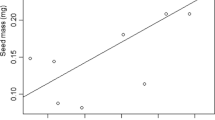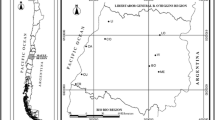Abstract
Stipa-species are wide-spread in Central Asia, but sexual reproduction in the dry steppes is rare. To facilitate conservation and restoration of these important rangelands, we studied germination characteristics of three common Mongolian Stipa-species under field- and lab conditions. Seeds of Stipa krylovii, Stipa gobica and Stipa glareosa were sown at the study site in Southern Mongolia over two consecutive years during which period tests were carried out to ascertain whether competition or herbivory are the main constraints of seedling establishment. In addition, we tested germination and seed viability in the laboratory under two different temperature regimes (20/10°C and 8/4°C), as well as the effect of cold-stratification. The lab experiments also included S. krylovii seeds originating from three climatically different provenances. None of the three Stipa-species seedlings emerged during the first 2 years of the field study. However, after an unusually intense rain event in the third year, 3% of S. krylovii, 0.6% of S. glareosa and 0.1% of S. gobica seeds germinated in the study plots. The factors ‘sowing-year’ and ‘vegetation’ significantly affected seedling emergence, whereas grazing had no effect at all. Under laboratory conditions a high percentage of viable seeds of S. gobica and S. glareosa germinated at both incubation temperatures, and cold-stratification had no effect on germination or viability. Germination of S. krylovii seeds required warmer temperatures and cold-stratification had a positive effect. Such evidence for dormancy was more pronounced in seeds from the moister, northern provenances. Germination of Stipa-species in the field is rare and only possible under exceptionally moist conditions. Conservation should thus concentrate on steppe conservation rather than on restoration. Where artificial reseeding is necessary, differences among species and also among different seed provenances should be taken into account.





Similar content being viewed by others
References
Ackerman TL (1979) Germination and survival of perennial plant species in the Mojave Desert. Southwest Nat 24(3):399–408
Bai YF, Li DX, Xu ZX, Wei ZJ (1999) Growth and reproduction of Stipa krylovii population on a grazing gradient. Acta Phytoecologica Sinica 19(4):479–483
Baskin CC, Baskin JM (2001) Seeds. Ecology, biogeography, and evolution of dormancy and germination. Academic Press, San Diego, San Francisco, New York, Boston, London, Sydney, Tokyo
Boeken B, Ariza C, Gutterman Y, Zaady E (2004) Environmental factors affecting dispersal, germination and distribution of Stipa capensis in the Negev Desert, Israel. Ecol Res 19(5):533–540
Bowers JE (1994) Natural conditions for seedling emergence of three woody species in the northern Sonoran Desert. Madrono 41(2):73–84
Bowers JE (1996) Seedling emergence on Sonoran Desert dunes. J Arid Environ 33(1):63–72
Brown W (1952) The relation of soil moisture and cleistogamy in Stipa leucotricha. Bot Gaz 113(4):438–444
Call CA, Spoonts BO (1989) Characterization and germination of Chasmogamous and basal axillary Cleistogamous florets of Texas Wintergrass. J Range Manage 42(1):51–55
Casper BB, Jackson RB (1997) Plant competition underground. Ann Rev Ecol Syst 28:545–570
Cheng X, An S, Chen J, Li B, Liu Y, Liu S (2007) Spatial relationships among species, above-ground biomass, N, and P in degraded grasslands in Ordos Plateau, northwestern China. J Arid Environ 68(4):652
Clark FE, Woodmansee RG (1992) Nutrient cycling. In: Coupland RT Book (eds) Ecosystems of the world, vol 8A. Elsevier. Amsterdam, London, New York, Tokyo, pp 137–149
Fenner M, Thompson K (2005) The ecology of seeds. Cambridge University Press, Cambridge
Fulbright TE, Redente EF, Wilson AM (1983) Germination requirements of green needlegrass (Stipa viridula Trin.). J Range Manage 36(3):390–394
Gasque M, Garcia-Fayos P (2003) Seed dormancy and longevity in Stipa tenacissima (L.) Poaceae. Plant Ecol 168:279–290
Ghermandi L (1995) The effect of the awn on the burial and germination of Stipa speciosa (Poaceae). Acta oecologica (Montrouge) 16(6):719–728
Gubanov IA (1996) Conspectus of the flora of outer Mongolia (vascular plants). Valang Publishers, Moscow
Gutterman Y, Gozlan S (1998) Amounts of winter or summer rain triggering germination and ‘the point of no return’of seedling desiccation tolerance, of some Hordeum spontaneum local ecotypes in Israel. Plant Soil 204(2):223–234
Haase P, Pugnaire FI, Incoll LD (1995) Seed production and dispersal in the semi-arid tussock grass Stipa tenacissima L. during masting. J Arid Environ 31:55–65
Hensen I, Müller C (1997) Experimental and structural investigations of anemochorous dispersal. Plant Ecol 133(2):169–180
Hijmans RJ, Cameron SE, Parra JL, Jones PG, Jarvis A (2005) Very high resolution interpolated climate surfaces for global land areas. Int J Climatol 25:1965–1978
Hilbig W, Jäger E, Knapp HD (2004) Die Vegetation des Bogd-uul bei Ulaanbaatar (Mongolei)—Standortsbindung und pflanzengeographische Stellung. Fed Repert 115(3–4):265–342
Hilbig W, Opp C (2005) The effects of anthropogenic impact on plant and soil cover in Mongolia. Erforschung biologischer Ressourcen der Mongolei 9:163–178
Holmgren M, Scheffer M, Huston MA (1997) The interplay of facilitation and competition in plant communities. Ecol 78(7):1966–1975
Huang Z, Gutterman Y (2003) Comparison of germination strategies of Artemisia ordosica with its two congeners from deserts of China and Israel. Acta Bot Sin 42(1):71–80
Keller M, Kollmann J (1999) Effects of seed provenance on germination of herbs for agricultural compensation sites. Agr Ecosyst Environ 72(1):87–99
Lavrenko EM, Karamysheva ZV (1993) Steppes of the former Soviet Union and Mongolia. In: Coupland RT Book (eds) Ecosystems of the world, vol 8b. Elsevier. Amsterdam, London, New York, Tokyo, pp 3–59
Li DX, Bai YF, Zhixin X (1997) Growth and reproduction of Stipa krylovii population under a grazing gradient. Chin J Arid Land Res 10(1):31–37
McPherson GR (1993) Effects of herbivory and herb interference on oak establishment in a semi-arid temperate savanna. J Veg Sci 4(5):687–692
Miklayeva IM, Gunin PD, Slemnev NN, Bazha SN, Dorofeyuk NI (2005) Impact of cattle grazing on species composition and dominants productivity in steppe ecosystems in Mongolia. In: Ecosystems of Mongolia and frontier areas of adjacent countries: natural resources, biodiversity and ecological prospects: Proceedings of the International Conference., Ulaanbaatar, 2005
Peart MH (1984) The effects of morphology, orientation and position of grass diaspores on seedling survival. J Ecol 72(2):437–453
Ponomarev AN (1961) Klejstogamiya u Kovylej. (Cleistogamy in feather grasses (Stipa spp.)). Botanitsheskyi Zhurnal 9:1229–1236
Qi J (1998) Aerial sowing for sand control in China. Science Press, Beijing
Ren J, Tao L, Liu X-M (2002) Effect of water supply on seed germination of soil seed-bank in desert vegetation. Acta Bot Sin 44(1):124–126
Retzer V, Nadrowski K, Miehe G (2006) Variation of precipitation and its effect on phytomass production and consumption by livestock and large wild herbivores along an altitudinal gradient during a drought, South Gobi, Mongolia. J Arid Environ 66:135–150
Ronnenberg K, Wesche K, Hensen I (2006) Effects of differing annual precipitation levels on seed viability of two Stipa-species of southern Mongolia. In: Abstracts of the 19th Annual conference of the section plant population biology of the ecological society of Germany, Switzerland and Austria, Halle (Saale), 2006
Ronnenberg K, Wesche K, Pietsch M, Hensen I (2007) Seed germination of five mountain steppe species of Central Asia. J Arid Environ. doi: 10.1016/j.jaridenv.2007.04.012
Sasaki T, Okayasu T, Takeuchi K, Jamsran U, Jadambaa S (2005) Patterns of floristic composition under different grazing intensities in Bulgan, South Gobi, Mongolia. Grassl Sci 51(3):235–242
Schöning C, Espalader X, Hensen I, Roces F (2004) Seed predation of the tussock-grass Stipa tenacissima L. by ants (Messor spp.) in south-eastern Spain: the adaptive value of trypanocarpy. J Arid Environ 56:43–61
Sneath D (1998) State policy and pasture degradation in Inner Asia. Science 281(21):1147–1148
SPSSInc. (2003) SPSS for windows 12.0G. SPSS Inc., Chicago
Thompson K, Band SR, Hodgson JG (1993) Seed size and shape predict persistence in soil. Funct Ecol 7(2):236–241
van Staalduinen MA, Anten NPR (2005) Differences in the compensatory growth of two co-occurring grass species in relation to water availability. Oecologia 146(2):190–199
von Wehrden H, Wesche K, Reudenbach C, Miehe G (2006) Mapping of large-scale vegetation pattern in southern Mongolian semi-deserts—an application of LANDSAT 7 data. Erdkunde 60:261–272
Wang JL, Zhao NX, Gai YB, Lin F, Ren AZ, Ruan WB, Chen L (2006) RAPD analysis of genetic diversity and population genetic structure of Stipa krylovii reshov. in inner Mongolia steppe. Russ J Genet 42(5):468–475
Wesche K, Miehe S, Miehe G (2005a) Plant communities of the Gobi Gurvan Sayhan National Park (South Gobi Aimag, Mongolia). Candollea 60:149–205
Wesche K, Ronnenberg K, Hensen I (2005b) Lack of sexual reproduction in dry mountain steppe populations of the clonal shrub Juniperus sabina L. in southern Mongolia. J Arid Environ 63:390–405
Wesche K, Pietsch M, Ronnenberg K, Undrakh R, Hensen I (2006) Germination of fresh and frost-treated seeds from dry Central Asian steppes. Seed Sci Res 16:123–136
Wesche K, Nadrowski K, Retzer V (2007) Habitat engineering under dry conditions: the impact of Pikas (Ochotona pallasi) on vegetation and site conditions in southern Mongolian steppes. J Veg Sci 18(5):665–674
Wesche K, Ronnenberg K, Retzer V (in prep.) Effects of herbivore exclusion in southern Mongolian desert steppes.
White JJ, Van Auken OW (1996) Germination, light requirements, and competitive interactions of Stipa leucotricha (Gramineae). Southwest Nat 41(1):27–34
Wu Z-Y, Raven PH (2006) Poaceae. Science Press, Beijing
Yuan ZY, Li LH, Han XG, Chen SP, Wang ZW, Chen QS, Bai WM (2006) Nitrogen response efficiency increased monotonically with decreasing soil resource availability: a case study from a semiarid grassland in northern China. Oecologia 148(4):564–572
Zhan X, Li L, Cheng W (2007) Restoration of Stipa krylovii steppes in inner Mongolia of China: assesment of seed banks and vegetation composition. J Arid Environ 68:298–307
Zheng Y, Xie Z, Gao Y, Shimizu H, Jiang D, Yu Y (2003) Ecological restoration in northern China: germination characteristics of nine key species in relation to air seeding. Belg J Bot 136:129–138
Zheng Y, Xie Z, Gao Y, Jiang L, Shimizu H, Tobe K (2004) Germination responses of Caragana korshinskii Kom. to light, temperature and water stress. Ecol Res 19(5):553–558
Acknowledgements
Andred Tuvshin and Christine Bläß helped to collect seeds and Sebastian Ploch provided invaluable assistance in the laboratory. We thank the German Science Foundation (DFG), the German Ministry for International Cooperation (BMZ), the German Academic Exchange Service (DAAD) and the AFW-Schimper-Foundation for funding. Research permission and access to field sites was kindly granted by the Mongolian government and the administration of the Gobi Gurvan Saykhan National Park. Michael Bren and Danny McCluskey kindly corrected our English. This is contribution No. 280 in the series “Results of the German-Mongolian Biological expeditions since 1962”.
Author information
Authors and Affiliations
Corresponding author
Rights and permissions
About this article
Cite this article
Ronnenberg, K., Wesche, K. & Hensen, I. Germination ecology of Central Asian Stipa spp: differences among species, seed provenances, and the importance of field studies. Plant Ecol 196, 269–280 (2008). https://doi.org/10.1007/s11258-007-9351-4
Received:
Accepted:
Published:
Issue Date:
DOI: https://doi.org/10.1007/s11258-007-9351-4




